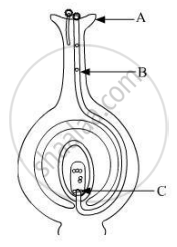Advertisements
Advertisements
प्रश्न
Give any two examples of agents of pollination.
उत्तर
Examples of agents of pollination are:
- Insect pollination: Bees are the most common and recognised insect pollinators.
- Bird pollination: Plants are pollinated by some birds, particularly humming birds.
APPEARS IN
संबंधित प्रश्न
Name the parts A, B and C shown in the diagram and write their functions.

How does fertilisation occur in flowers? Name the parts of the flower that develop into (i) seed, and (ii) fruit after fertilisation.
What is the name of female part of a flower?
Where is the male gamete formed in flowering plants?
Fill in the following blank with suitable word :
Ovules contain ......... gametes of a plant.
Fill in the following blank with suitable word :
The female organ of reproduction in the flower is the...........
Explain the terms 'cross-pollination'?
Name the part of a seed which contains stored food.
The part of a seed which grows and develops into root on germination is :
(a) cotyledon
(b) plumule
(c) follicle
(d) radicle
The flask-shaped organ A at the centre of a flower is surrounded by a number of little stalks B having swollen tops which lie just inside the ring of petals.
(a) Name A. What are the various parts of A?
(b) Which part of A contains gametes?
(c) Name B. What is the swollen top of B known as?
(d) What does the swollen top of b contain?
(e) Out of A and B, which one is (i) male part, and (ii) female part of the flower?
When an insect sits on the flower of a plant then some particles A present in the top of little stalks in the flower attach to its body hair. When this insect now sits on the flower of another similar plant, then particles A attached to the hair of insect are put on the top of a flask-shaped organ at the centre of flower. The particle A grows a long tube b from the top of flask-shaped organ through which C moves down and reaches the bottom part of flask-shaped organ. Here C fuses with the nucleus of d contained in structure E. the fusion of C and D forms a new cell f which grows and develops into a seed of the plant.
(a) What are particles A? What is the process of transferring A from one flower to another flower of similar plant by the insect known as?
(b) What is the name of tube B?
(c) What is C which moves down through the tube B?
(d) Name D and E.
(e) What is F?
In a bisexual flower, inspite of the young stamens being removed artificially, the flower produces fruit. Explain.
In what ways is fertilisation in a plant similar to fertilisation in a human?
Put a tick mark (✓) against the correct alternative in the following statement
Reproductive whorls of a flower are:
What is a flower ? Draw a neat labelled diagram showing the L.S. of a typical flower.
What part is played by stamens and carpels in reproduction?
The students of a class were asked by the teacher to study the different parts of an embryo of an angiosperm. Given below are the essential steps for the experiment :
A. Soak the seeds in plain water and keep them overnight.
B. Cut open the soaked seed and observe its different parts.
C. Take some healthy seeds in a petri-dish.
D. Drain the excess water, cover the seeds with a wet cotton cloth and leave them as it is for a day.
The correct sequence of these steps is
(a) C, A, D, B
(b) C, D, A, B
(c) A, C, D, B
(d) A, C, B, D
Draw a diagram of the longitudinal section of a flower and label on it sepal, petal, ovary and stigma.
What is pollination? Mention its types.
A student is observing the temporary mount of a leaf peel under a microscope. Draw a labelled diagram of the structure of stomata as seen under the microscope
Find the odd one out:
Pollen grains are formed by _________ division in locules of anthers.
Pollen tube reaches the embryo sac via style.
In which of the following manner the arrangement of megaspores in a tetrad is observed in angiosperms?
The ovule of an angiosperm is technically equivalent to ______
Which type of development is observed in male gametophytes of plants?
Gloriosa superba exhibits ______.
The flower of the Hibiscus plant is ______
Pollen grains are produced by ______
Variations occur as a result of ______
Which out of the following processes does not lead to the formation of clones.
Which among the following statements are true for unisexual flowers?
- They possess both stamen and pistil
- They possess either stamen or pistil
- They exhibit cross pollination
- Unisexual flowers possessing only stamens cannot produce fruits
Give reason for the following:
Fertilization cannot take place in flowers if pollination does not occur.
Double fertilization is exhibited by ______
In a plant flower the female whorl is ______.
The figure below shows the concept of double fertilization. Complete the flow chart showing the progress at each step:

Name the reproductive parts of an angiosperm. Where are these parts located? Explain the structure of its male reproductive part.
Explain the post fertilization changes that occur in the ovary of a flower.
